Feature: Get Warped. Free weaving tutorial using singles yarn by rigid-heddle loom expert Liz Gipson
Get Warped
Get Warped: The Singles Life II: Weaving with Handspun Singles
In my last column, I went on, and on, and on about how much I love singles. I'm going to go on some more, this time for the handspinners in the house.
Commercial singles are spun, for the most part, to be balanced. They are also finished in some way that stabilizes them: washed and set, steamed. Some are even chemically set, though the latter is rare in yarns designed for the handmade market. Spinning a balanced single is a goal for some spinners, but that's not what we are talking about here.
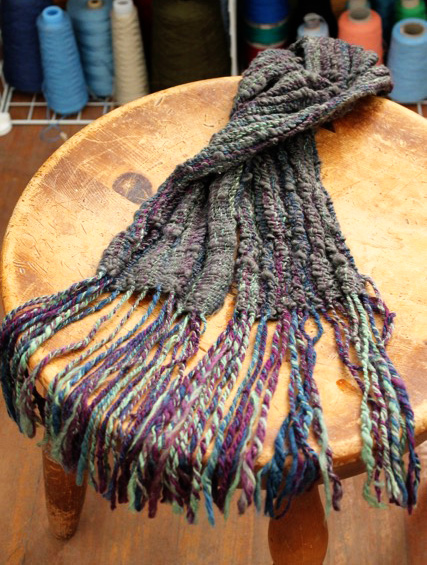 I can't remember the last time I plied my handspun. Once I learned how to harvest the energy of handspun singles in woven cloth, I never saw a reason to take my yarn any further. If you are a new spinner, all of your first handspun yarn that you bemoan as being too lumpy and bumpy will look great on your loom.
I can't remember the last time I plied my handspun. Once I learned how to harvest the energy of handspun singles in woven cloth, I never saw a reason to take my yarn any further. If you are a new spinner, all of your first handspun yarn that you bemoan as being too lumpy and bumpy will look great on your loom.
Take this scarf, for instance. It is made of yarn that is probably very similar to that first beginner yarn you made or are making. Woven with a handspun Karaoke Soy Silk/wool blend in the warp and Black Diamond carbonized bamboo top in the weft, both fibers by SouthWest Trading Company. These yarns were highly inconsistent in their grist. Note the self-twisting fringe, a phenomenon mentioned in my last column.
Chance are that the singles you are spinning have some pent-up energy that will show up in your woven cloth. For instance, a common school of thought is that you add extra twist to singles that you plan to ply because the plying process removes some of that energy. That yarn is most likely perfect for this weaving technique.
The Secret is in the sauce
Singles with extra energy are often referred to as high-twist or energized yarn. Instead of washing and setting your yarn as you would with a plied or balanced singles, this yarn is bathed in a stiffener and then dried under tension to make the yarn manageable during the warping and weaving process. After weaving, the sizing is washed away, and the restrained energy is released. (What constitutes “high” twist is debatable and can depend on fiber type and construction. See How Much Twist below.)
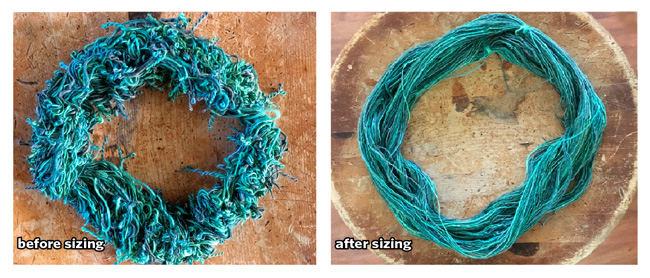
Watered-down glue, flour, gelatin, and starch are all common materials used to size yarn. Sarah Anderson turned me on to Xanthan Gum and I've been hooked on it ever since. While some of the other materials I mentioned can be drying, Xanthan Gum is very gentle on yarns. Xanthan Gum is a common thickening ingredient in foods, such as salad dressing. It can be found at most Whole Foods or similar grocery stores.
To make the sizing, pour 4 cups of water into a blender. Place the lid on the blender and remove center plug. Run the blender on the lowest setting and slowly add 2 Tbsp Xanthan Gum. Mix until well blended, increasing the speed if necessary. The result will be a gelatinous goo. You can store excess sizing in the fridge for a week, or longer in the freezer.
Regardless of your sizing material, the process of sizing yarn is the same. Wind the yarn into a skein, using three or four figure-eight ties to keep the yarn organized. Soak the yarn in room-temperature water for about ten minutes, then remove and press out the water. Wetting the yarn will help it absorb the sizing better.
Now the fun begins. Place a generous amount of sizing in a bowl and work the yarn into it. Once the sizing is worked in, squeeze out any excess.
Hang the yarn under tension to dry for a few days. I use a full spray bottle and hook the bottle's trigger handle over the skein. Move the weight from time to time and pull the yarn apart to be sure that it fully dries. Once dry, wind the yarn into a tight ball to keep the energy restrained until use.
There is another way to harness that energy that you are probably already doing. If you leave your yarn on a bobbin for an extended period of time, you may notice that the visible twist disappears. Sometimes I can get away with weaving “bobbin set” singles without sizing the yarn. Once I wet finish the cloth, all that energy comes back to life. Be warned though, sometimes the heat and moisture in my hands will bring that twist back to life halfway through the warping process. Take this approach at your own risk: bobbin-set yarn is never as stable as sized yarn.
Fiber Selection, Preparation, Construction
As mentioned in the previous column, fiber selection, preparation, and construction make a difference in the final yarn and cloth. Combed long-stapled fibers with low crimp will have less dramatic results than short-carded fibers with high crimp.
Shown here are two examples. Below is my own homegrown cashmere. The sample at left was made with a worsted single with about 30 degrees of twist in both the warp and weft. The sample at right was made with the same worsted single in the warp, and a woolen single with lower twist in the weft. The effect is pretty different.
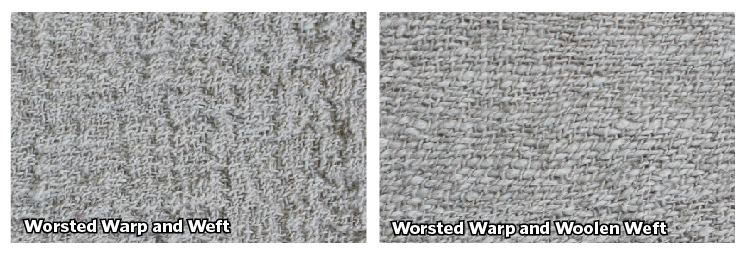
This is a set of samples I made using SweetGeorgia Yarns 2015 Spinzilla colorway and my Swatch Maker Looms. It is a 75/25 blend of BFL and silk. Both have considerably longer staple lenghts than cashmere. I worked up three samples in different setts. On the left are the samples before washing, and on the right are the samples after washing. The color and twist are more visible at the closer setts, but the hand is stiffer.
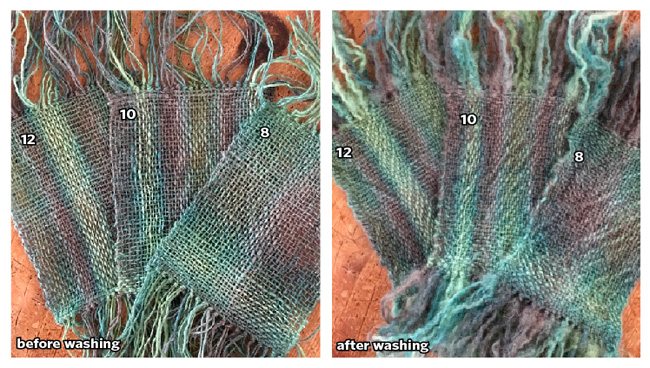
How much twist?
Long, wavy fibers need less twist than short, crimpy fibers. For your typical medium-to-fine fibers, twist over 25 degrees will give you a crepe-like look. The more twist, the more dramatic the effect; however, some fibers start to get hard and rope-like when the twist angle exceeds 40 degrees.
Measuring Twist
It helps to see the twist angle if you spin a little contrasting fiber into the yarn at the end of your bobbin. If you are using a variegated fiber, look for areas in the yarn where there are color transitions.
Measure the twist angle before you size it. You can use a protractor to measure twist or check with your favorite spinning supplier for a twist gauge, which I find are a little bit easier to use, if you are new to the technique.
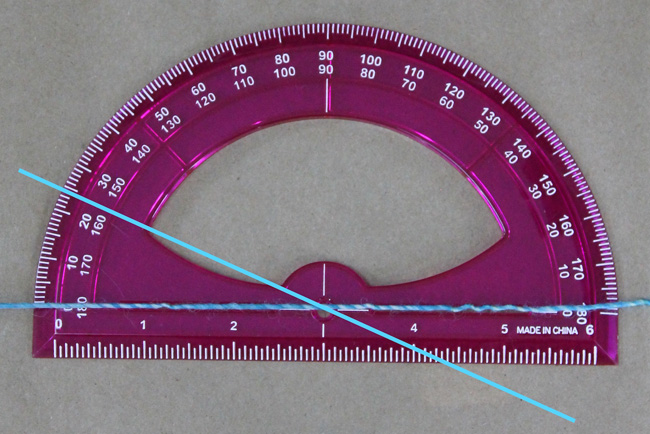
To measure twist angle using a protractor, place the protractor at the 0 degree line or straight edge of the protractor. You can use painter's tape to hold the yarn in place, being careful not to skew the twist by placing the yarn under a lot of tension. Starting in the center, draw an imaginary line every 5 degrees until you find an angle that lines up with your yarn.
It can be challenging to figure out exactly which angle lines up best with your yarn. You may find it helpful to use a piece of paper, straight edge or another piece of yarn that is approximately the same grist to line up the twist. Keep playing around with your angles until you find the one that best aligns with your yarn. You will know it when you see it.
The yarn shown here has a twist angle that measures about 24 degrees. Knowing the angle to the exact degree isn’t necessary. You just want a general idea.
Weaving with Sized Singles
Degree of twist is just half the equation. You want to use an open sett and a light beat when weaving with sized singles. How open depends on your yarn and the amount of twist. For rigid-heddle weaving, I'll select a sett one size larger than the yarn's balanced plain weave sett.
Shown here are the before and after photos of the cowl fabric from my Crepe Cowl Workbook. Note the open gauze-like appearance of the fabric fresh off the loom. It is stiff with sizing and you can clearly see through the fabric. After washing, the twist energy is released. The fabric is still open, but the right angles of the yarn interlacements are broken and the cloth is full of life.
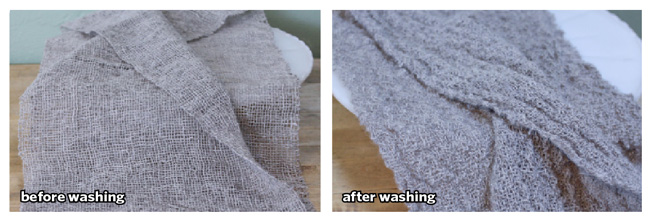
To determine the sett of a textured singles that has a lot of thick and thin sections, such as the handspun scarf at the opening of this article, wrap the warp yarns around a ruler for about 4'' and then take an average to get your wraps-per-inch. See First Fall 2015 Get Warped Knitty column for tips on sett.
There you have it, my complete love affair with singles in two columns. Next up, we talk color! Now go make your heddles happy.
ABOUT THE DESIGNER
 Liz Gipson is a lover of yarn and that from which it comes – namely the mills and fiber-bearing critters and plants. She is the author of the newly revised Weaving Made Easy and has four video workshops for rigid-heddle weaving published by Interweave. She is working on a new book, Handwoven Home, due out in the spring of 2017.
Liz Gipson is a lover of yarn and that from which it comes – namely the mills and fiber-bearing critters and plants. She is the author of the newly revised Weaving Made Easy and has four video workshops for rigid-heddle weaving published by Interweave. She is working on a new book, Handwoven Home, due out in the spring of 2017.
Curious about the warped side of yarn? Visit Liz's website Yarnworker, for know-how and inspiration, or hang out with her @yarnworker on Facebook, Twitter, Instagram and Ravelry.
Pattern & images © 2016 Liz Gipson. Contact Liz




